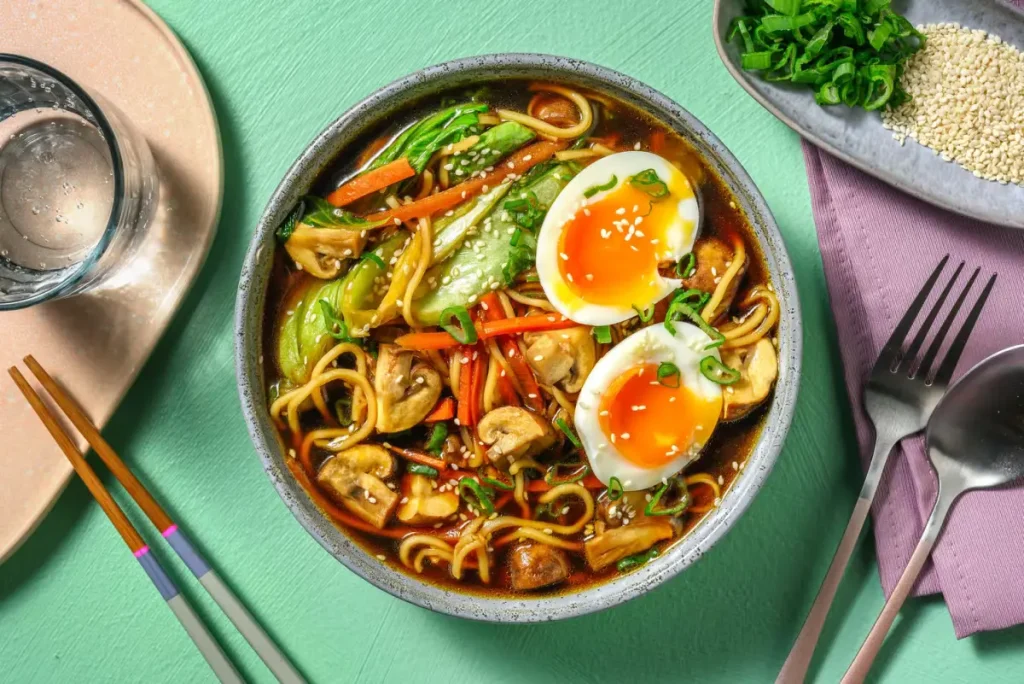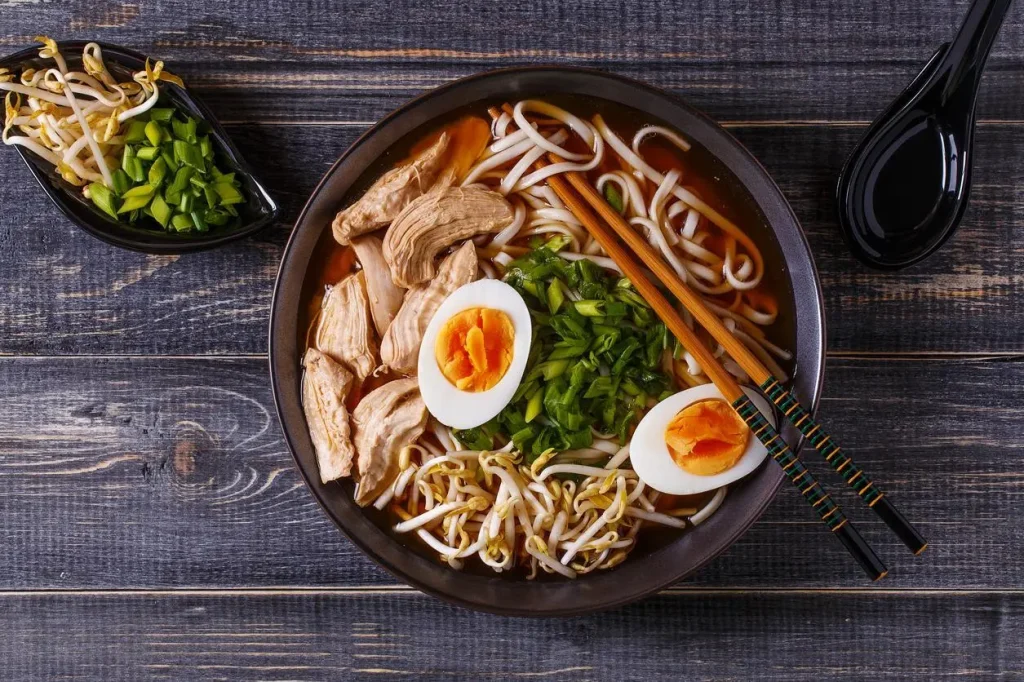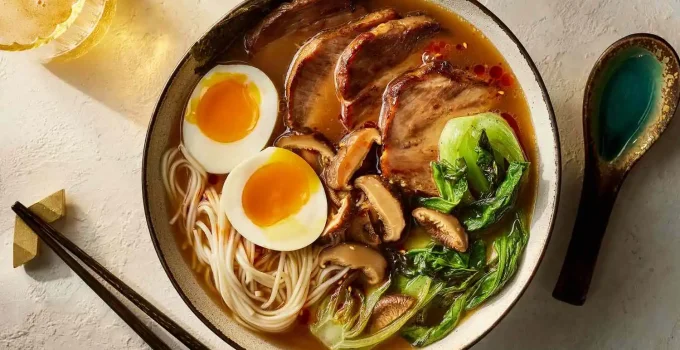Page Contents
ToggleRamen is synonymous with Japanese soul food, a bowl of noodles combines with broth, but it is much more than that. It is full of distinct and diverse flavors that make it a favorite dish for everybody who enjoys diverse food. Every component in a bowl of ramen is ideal, from the hot broth to the chewy noodles. This paper discusses Ramen’s background and provides an insight into the ramen culture and cooking process, which includes a variety of tastes throughout the world that have intrigued ramen lovers.
The Rich History of Ramen
Origins and Evolution
Its origins are sourced to the early 20 th century Japan, where the Chinese-style noodle soup was modified by the Japanese chefs . It became one of the most popular meals, especially in the post-WWII period, due to its quick and cheap preparation. During the years, ramen chefs perfected the recipe and preparation process to turn an ordinary meal into a gourmet dish . Present-day ramen is regarded as an art in Japan, with every region having its special ramen dish that is varied to the local ingredients and flavors.
Cultural Impact
Ramen is no longer just a passing fad in the food world but instead remains an integral part of Japanese culture. Today, ramen shops are prevalent throughout Japan, and every restaurant brings its personalized twist to the dish. There are even ramen museums and festivals to celebrate the variety and history of this frequently appreciated Japanese food.

Exploring the Varieties of Ramen
Regional Varieties
Ramen varies greatly by region in Japan, each bringing its own unique flavors and ingredients to the table:
- Tokyo-style Ramen: Features a soy sauce-based broth, typically with slightly curly, medium-thick noodles.
- Sapporo-style Ramen: Known for its rich miso-based broth and hearty toppings like sweetcorn, butter, and roasted pork.
- Hakata-style Ramen: Offers a rich, milky, tonkotsu (pork bone) broth with thin, straight noodles that are often served al dente.
Innovative Styles
As ramen has gained international fame, chefs around the world have introduced innovative twists to the traditional dish. This includes everything from vegetarian and vegan versions, using rich, savory mushroom broths and tofu, to fusion dishes that incorporate local ingredients and flavors, creating a new experience for diners.
The Art of Crafting Ramen
Essential Components
A bowl of ramen consists of four basic elements, each vital to its flavor and character:
- Broth: The soul of the dish, it can be made from chicken, pork, beef, seafood, or even purely vegetables. The broth is seasoned with sauces and spices to create different flavor profiles such as shoyu (soy sauce), miso, and shio (salt).
- Noodles: Made from wheat, ramen noodles come in various sizes and shapes. Their texture and the degree of firmness (katamen) are often customizable according to personal preference.
- Toppings: Common toppings include sliced pork (chashu), green onions, nori (seaweed), bamboo shoots, and boiled eggs. Chefs often add their signature toppings to create a distinctive dish.
- Tare (seasoning base): The secret to a great ramen lies in its tare, which defines the overall flavor of the broth. It is added to the bottom of the bowl before the broth and can be soy sauce, miso, or salt-based.
Culinary Techniques
It is an art to prepare ramen due to the skill and precision involved. On the one hand, chefs need many parts to perfect the broth, and many take many years, trying different cooking times and combinations of ingredients to reach the flavor and consistency they will need For Handmade noodles, it also needs the touch to determine how one can create an ingredient likely to have a good bounce and grasp the broth very well.

The Global Popularity of Ramen
Ramen Shops and Restaurants Worldwide
From Tokyo to New York, and London to Sydney, ramen restaurants have popped up in cities across the globe. These eateries range from casual noodle houses to high-end restaurants where chefs elevate ramen to a luxury dining experience.
Cultural Exchanges and Collaborations
The international ramen scene is vibrant and dynamic, characterized by ongoing cultural exchanges and collaborations between chefs from different culinary backgrounds. This global community not only shares knowledge and techniques but also continuously inspires new and innovative approaches to ramen.
Nutritional Profile of Ramen
Health Considerations
Traditional ramen is food that is not only nourishing but also should be evaluated not only for taste qualities but also from a nutritional point of view. Thus, the broth, especially when using the bones, is rich in minerals and natural collagen – connective tissue, which is beneficial for the joints. At the same time, in certain circumstances associated with the use of a commercial base or an excessive amount of condiments, there may be too much salt. Modern people follow healthier eating practices, and many chefs prepare dishes from which are less salty or to which they also add more vegetables.
Customizing for Dietary Needs
Ramen’s versatility also allows it to be adapted to different dietary requirements. There are growing eateries offering vegetarian or even vegan options with seaweed or vegetable broth as the base and adding meat alternatives, such as tofu, in addition to traditional mushrooms and arugula. Individuals who are gluten intolerant can also enjoy ramen by replacing traditional wheat-based noodles with rice flour or other gluten-free analogs.
The Social Experience of Ramen Dining
Ramen as a Communal Activity
Ramen’s preparation and consumption can be a communal activity that enhances its enjoyment. In Japan, ramen shops are places where people from all walks of life gather, sharing the common experience of enjoying a nourishing bowl of noodles. This aspect of ramen dining transcends cultural boundaries, making it a social staple in various parts of the world.
Ramen Competitions and Events
Ramen competitions and food festivals celebrate the creativity and culinary skills of ramen chefs. These events often feature new and innovative ramen styles, fostering a spirit of competition and camaraderie among chefs. Participants and attendees alike enjoy the festive atmosphere and the opportunity to taste different ramen flavors from around the world.
Marketing Ramen in the Global Market
Branding and Promotion
Branding and promotion have been crucial in the global popularity of ramen. Restaurant names and instant ramen packaging are clever and easy to remember. Social media work in the sphere of marketing has significantly promoted ramen’s well-knownness. Besides, many fashion bloggers, critics and lovers, write their experience in social networks.
Cultural Adaptations in Marketing
Marketing strategies often adapt to fit cultural contexts, highlighting the versatility of ramen to resonate with local tastes while retaining its authentic essence. This localized approach in marketing helps to increase ramen’s appeal across diverse consumer bases, contributing to its global success of togelon.

Future Trends in Ramen Cuisine
Technological Innovations
The future of ramen may see more technological innovations, especially in the way it is prepared and served. Automation in noodle production and AI-driven cooking techniques that can simulate the skills of expert chefs are potential developments. These technologies could revolutionize ramen preparation, making it more accessible while maintaining high quality.
Sustainability in Ramen Production
As sustainability becomes more important to consumers, ramen producers and restaurants are looking for ways to reduce their environmental impact. This includes sourcing ingredients locally, minimizing food waste, and using eco-friendly packaging, especially for instant ramen products.
The Enduring Legacy of Ramen
Ramen has not only transcended beyond just a dish to enjoy but has become a cultural experience that unites people of all walks of life and taste. The soup has grown from a soup and noodle combination to a world phenomenon due to its exceptional flexibility and inclusiveness. Be it on the market streets of Tokyo watching the cook prepare your noodles and broth or a fancy restaurant in New York; Ramen has tasted different for everyone.
The dish continues to engage and excite wherever you go, with various forms and designs becoming more visible in today’s culinary world. While the dish continues to produce innovative tastes and respond to the tastes of diners around the world, Ramen stays bright and alive, cherished for its distinct flavor, strong culture, and worldwide impact on meals.
Also read: Mechanics of Hard Work: Understanding the Path to Success



